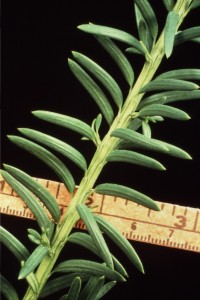Taxus

I see the urn against the yew,
The sunlit urn of sculptured stone,
I see its shapely shadow fall
On this enormous garden wall
Which makes a kingdom of its own
– John Betjeman
You will find yews accentuating monuments in every corner of Mount Auburn, not surprising for a tree used over many centuries and cultures symbolizing both death and rebirth. Planted in cemeteries in Europe, Asia, North America, and Australia these trees and shrubs are frequently used as single specimens, symmetrical pairs, or hedges as alluded to above. In the country of Georgia it once was known as the “tree of life.” In Japan some referred to it as the “tree of God.” Yew branches were placed in the grave before the body was lowered in both Greece and Rome. These auras of hope and rebirth exist in contrast with the yew’s long reputation of morbidity justified by the reality that its evergreen needles, seeds, and bark are poisonous.
Known to botanists as the conifer genus Taxus or yew, there is current consensus that there are eight species worldwide, occurring on various continents and in diverse climates. At Mount Auburn there are more yews planted than any other tree or shrub genera.
Taxus cuspidata, Japanese yew, may be a small tree or large shrub capable of growing 10′-50′ tall with flat, dark green, pointed leaves about one inch long and 1/8” wide. Most yews are dioecious meaning there are separate male and female plants each with inconspicuous flowers in the spring. If successfully fertilized the female flowers will produce a modified seed cone in autumn, each about ½ inch in diameter and containing a single seed surrounded by a soft red berry-like structure called an aril. These arils, which are not poisonous, are eaten by thrushes, waxwings and other birds. The Japanese yew is very cold hardy; categorized USDA zone 4-7, it withstands full sun to shade, and it can tolerate heavy pruning, which results in it being an ideal choice for topiary.
 This horticultural favorite was introduced to the United States from Japan in 1862 by Dr. George Rogers Hall (1820-1899) of Bristol, Rhode Island. A physician from the Harvard Medical School’s (HMS) class of 1846 he likely studied under Dr. Jacob Bigelow (1786-1879), Mount Auburn’s founder who taught materia medica for forty years 1815-1855, at HMS. Dr. Hall transitioned to become a China trader and later lived for two years in Yokahama, Japan where, in his garden, he assembled numerous Japanese species, many unknown to the U. S. or Europe. A cultivated variety, Taxus cuspidata ‘Nana’, the dwarf Japanese yew which grows only 4′-12′ tall is actually the yew most planted (over 280) in our landscape.
This horticultural favorite was introduced to the United States from Japan in 1862 by Dr. George Rogers Hall (1820-1899) of Bristol, Rhode Island. A physician from the Harvard Medical School’s (HMS) class of 1846 he likely studied under Dr. Jacob Bigelow (1786-1879), Mount Auburn’s founder who taught materia medica for forty years 1815-1855, at HMS. Dr. Hall transitioned to become a China trader and later lived for two years in Yokahama, Japan where, in his garden, he assembled numerous Japanese species, many unknown to the U. S. or Europe. A cultivated variety, Taxus cuspidata ‘Nana’, the dwarf Japanese yew which grows only 4′-12′ tall is actually the yew most planted (over 280) in our landscape.
Taxus baccata, English yew, native to Europe, northwestern Africa, northern Iran and southwest Asia is a small to medium-sized tree 30′-60′ tall with leaves, flowers and fruits similar to those described above but is a bit less cold hardy, categorized USDA zones 5-7. A relatively slow grower this is a species which speaks to annals of time as well as our landscape. Many a British churchyard includes English yews surviving from mediaeval days. As the oldest living plant species in Europe, ages from 1500 to 2000 years-old are documented. This yew has long been associated with longbows, an early weapon. In 1991, in the Tyrolean Alps of Italy, a frozen male body dated to be 5300 years-old was found together with a bow made of yew wood and a quiver full of arrows.
One final archeological yew fact, is that the Clacton spear, discovered in 1911, the oldest wooden spear to have been found in the British Isles dates back 400,000 years. Taxus baccata ‘Repandens’, the spreading English yew, a semi-prostrate cultivated variety growing 2′-5′ high is the most frequently planted member of this species here at Mount Auburn.
Taxus x × media, whenever you see the letter × between the genus (Taxus) and species (media) of a plant name that identifies this as a plant which had parentage from two different species, referred to as a hybrid. Our Taxus × media is the progeny from a cross between the Japanese yew and the English yew. The leaves, fruit, and bark are similar to that already noted. This is more typical of a shrub habit and there are over 230 planted throughout our landscape.
Taxus, which for centuries was known to be poisonous to humans, in recent decades has paradoxically resulted in advances in treatment for several forms of cancer. Paclitaxel is a pure compound initially identified in the bark of Taxus brevifolia, the pacific yew (not found at Mount Auburn) in 1965. Several decades later saw the successful semi-synthetic production of paclitaxel using the leaves of English yew. Currently this compound is produced using plant cell technology to help treat ovarian cancer, lung cancer, breast cancer, and Kaposi’s sarcoma. From the stone-age to our modern era of bioscience the yew has played a role in helping humankind to survive.
Leave a Reply